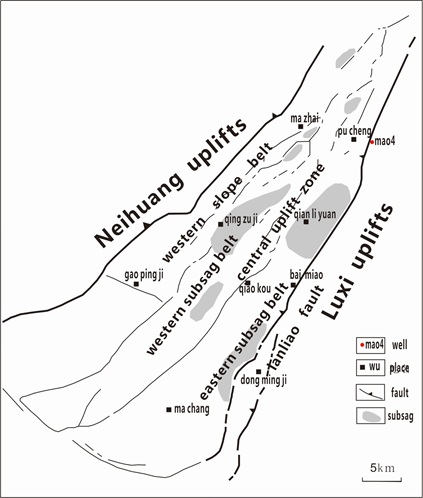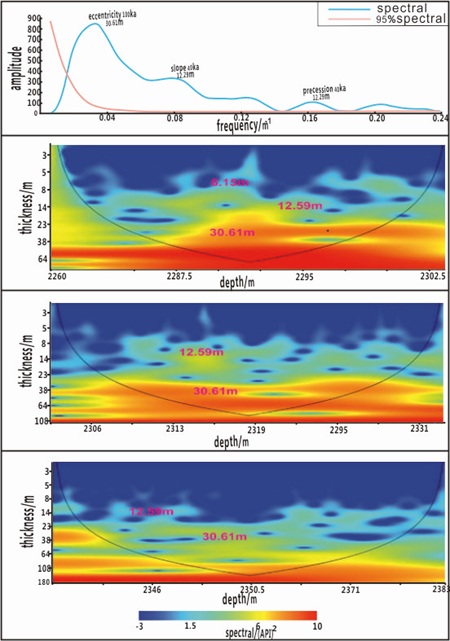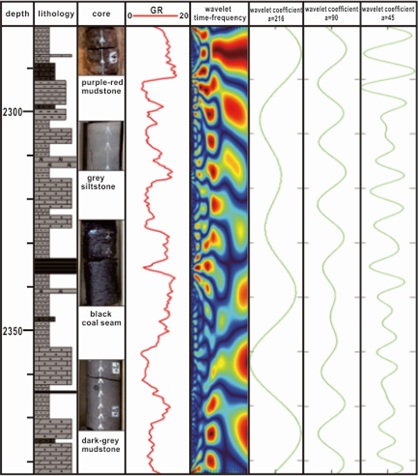
Calculation of Stratigraphic Sedimentation Rate of Shanxi Formation Based on Astronomical Period Identification
*Corresponding Author(s):
Zhang Dian-DongCollege Of Earth Science And Engineering, Shandong University Of Science And Technology, Shandong, China
Tel:+86 15269214839,
Email:1797176268@qq.com
Abstract
In order to restore the geological deposition process of the Shanxi Formation of the Upper Paleozoic in Dongpu depression, the Shanxi Formation of Mao 4 well was taken as the research object. In this paper, the method of frequency spectrum analysis and one-dimensional continuous wavelet transform is used to process the natural gamma logging curve which is closely related to the climate transform. The scale values identified through the high-frequency cycle thickness value and time-frequency chromatogram model extreme value analysis in the spectrum analysis are consistent with the ratio of the 3 elements of the earth orbit. The logging curve is subjected to one-dimensional wavelet at the scale corresponding to the wavelet mode extreme value. Decompose and compare the results of wavelet analysis with the results of spectrum analysis to divide the astronomical period in this stratum. The results show that the Shanxi Formation of the Mao 4 well in the Upper Paleozoic in the Dongpu Depression has preserved a total of 3.5 eccentricity cycles, 7.5 slope cycles and 13.5 precession cycles, and determined its relative time frame. Based on core and logging data, the Upper Paleozoic Shanxi Formation in the Dongyu depression was divided into three segments. Then, by performing spectrum analysis and wavelet transform on each interval, it was determined that the sedimentary rate of the Shanxi formation decreased first and then increased with time. Overall, the changes of the depth of water from deep to shallow, and then to deep.
Keywords
Astronomical period; Dongpu depression; Sedimentary rates; Spectrum analysis; Wavelet transformation
INTRODUCTION
With the development of science and technology today, scientists have long ceased to focus on simple absolute age dating, and astrostratigraphy with higher accuracy and resolution has become a new research focus [1]. Many scholars have done a lot of research work since the introduction of Milankovich cycle theory. The research period of Milankovich cycle theory has extended from the Quaternary to the Precambrian [2], and the research scope has been further expanded, almost including various types of sedimentary facies. The cycle period corresponding to the Milankovich cycle can be used as a natural scale for stratigraphic division [3-5] (Generally, the long eccentricity controls the fourth-order sequence, the short eccentricity controls the fifth-order sequence, and the slope and precession mainly control the sixth-order layer. sequence). The orbital driving force, as a stable extraterrestrial factor, may run through the entire geological history period. The ratio of the proportional relationship between the internal stability of the cycle and the thickness of the cycles at all levels can be used as the basis for the study of Milankovitch cycles [6].
Gilbert GK et al., [7] found regular changes in limestone and shale in the Niobrara chalk under the Colorado Rocky Mountains to link sedimentary cycles to orbital control; Hays et al., [8] published in Science in 1976. The article reports that after the discovery of the Milankovich cycle in the Quaternary deep-sea drilling core, the study of cyclostratigraphy by the international geoscience community has been in full swing.
The Dongpu depression is an inland lake basin that is extremely sensitive to climate change responses. In the strata of the Shanxi Formation in the Upper Paleozoic, the climate change experienced during the sedimentation period must be preserved. In this paper, Mao 4 well with a total length of 103.5 m and a relatively complete record of the sedimentary information of the Shanxi Formation in the Upper Paleozoic was selected as the research object in the northeast uplift area of Dongpu depression. The integrity of the stratum not only provides excellent conditions for the study of cyclic stratigraphy, but also provides favorable conditions for the calculation of the sedimentary rate based on the Milankovich cycle. After de-noising the natural gamma data of the Shanxi Formation, using technical methods such as spectrum analysis with 95% confidence interval and one-dimensional continuous wavelet transform, three reliable Milankovich cycles were identified, and the Dongpu was established. Floating high-resolution astronomical age scale of the Shanxi Formation in the Upper Paleozoic. The Shanxi core group was divided into three sedimentary bodies through the study of the cores taken. The sedimentation rates of these three sedimentary bodies were calculated respectively, which revealed the changes of the sedimentation rates in this section and provided strong evidence for the reduction of geological history.
GEOLOGICAL BACKGROUND
The Dongpu depression is located in the border area of the three provinces of Henan, Shandong, and Hebei. It is a Cenozoic fault-depression lake basin dominated by Paleogene sediments. The regional structure is located on the edge of the Bohai Bay Basin. The area is similar to a "pipa". It is about 62 kilometers wide in the south and 16 kilometers wide in the north, with a total area of about 5,300 square kilometers [9]. After the sedimentary of Paleozoic strata, the Dongpu Depression mainly experienced three tectonic evolution stages: Paleozoic-Triassic Craton Basin evolution, Paleogene fault depression, and Neogene-Quaternary depression. Later, it underwent superposition and transformation of Caledonian, Haixi, Indo-Chinese, Yanshan, Xishan and other tectonic movements, forming a "two subsag and one uplift" structural pattern (Figure 1).
 Figure 1: Dongpu depression structure.
Figure 1: Dongpu depression structure.
Shanxi Formation is an important coal-bearing stratum and the main source of hydrocarbons. Its lithology is composed of medium-fine-grained sandstone, mudstone, fine sandstone, coal seam and coal line. The top of the Shanxi Formation is a small purple mudstone with a purple-red mudstone, which is stable and widely distributed; the upper part is a charcoal sandstone, which is gray sandstone and sandy mudstone, rich in plant fossils; Medium-grained sandstone with coal seam; the lower part is coal seam 2; the bottom is light gray or gray-white medium-fine-grained sandstone. The sandstone at the bottom can be used to identify the boundary between Shanxi Formation and Taiyuan Formation.
DATA AND METHODS
In the stratigraphic sedimentary cycle, the periodic changes of sediments such as particle size, argillaceous content, and organic carbon content can all reflect the characteristics of periodic changes in paleoclimate [10-12]. Therefore, it is possible to use the relevant indicators in the formation sediments to study the Milankovich cycle, such as oxygen and carbon isotope, magnetic susceptibility, logging curves, etc., [13]. Because clay and organic matter have a stronger ability to absorb radioactive elements, and the natural gamma logging curve is mainly used to measure the intensity of gamma rays in the well [14-16], it can reflect the formation in the formation continuously and with high resolution. The natural gamma logging curve of clay and organic matter content can be used as an alternative indicator to reflect paleoenvironment and paleoclimate changes [17].
The natural gamma logging curve of the Upper Paleozoic Shanxi Formation in Well Mao 4 of Dongpu depression is used as the parameter curve for the cycle analysis of Milankovich. According to the log feedback data, the drilling process of Shanxi Formation of Mao 4 has not when encountering faults, the strata are relatively continuous. The Upper Paleozoic Shanxi Formation in Dongpu Depression is located at a well depth of 2279.5 ~ 2383m, with a total core length of 103.5m, a sampling interval of 0.125m, and a numerical range of 4.9-15.6API, which shows good cycleability. In this paper, band-pass filtering is used to preprocess the natural gamma logging data of the Shanxi Formation in the Upper Paleozoic in the Dongpu depression, eliminating the bias caused by the Milankovich cycle analysis due to environmental factors. In order to obtain higher confidence in the spectrum analysis, the author chooses the REDFIT spectrum program in the past software that can help users freely select the significance level. In this program, we mainly select the peak frequency with a confidence level of 95% or more for calculation. When choosing a program for wavelet analysis, I used MATLAB software. The one-dimensional continuous wavelet transform toolbox provided in the software allows us to choose the morlet wavelet to be the most suitable waveform in the current work. The wavelet it is smoothed by Gaussian function and its scaling scale has a one-to-one correspondence with the period T in Fourier analysis.
RESULTS
Theoretical orbital period
The periodic changes in the precession, slope, and eccentricity in the Earth's orbital parameters are caused by the gravitational interaction between the earth's and Earth-Moon system, the earth and the sun, and other planets. Among them, the revolution and rotation of the earth will cause the earth's axis to change periodically, so that the slope, eccentricity, and precession of the earth's axis also show approximately periodic changes. These periodic changes cause the periodic changes of the light received on the surface of the earth, which in turn causes periodic changes in the earth's surface and climate-related sedimentary strata.
In the long geological history of the earth, the earth has long been affected by the gravity of the Earth-Moon orbit and the tidal friction of waves caused by the continuous change of the Earth-Moon distance. The rotation speed of the earth gradually slows down, and the earth's axis slope and precession cycle gradually. Increase, according to previous research data collected by the author on the end of the Permian period in the astronomical cycle, it can be seen that the end of the Permian period has an eccentricity of a 100ka variation period, a slope of a 40ka variation period, and a precession of a 20ka variation period. Because the proportional relationship of these changing periods that existed at the end of the Permian is particularly stable, there is a short eccentricity: slope: precession of 5: 2: 1, which can be used as a benchmark for studying the astronomical cycle of the Shanxi Formation in the Upper Paleozoic of the Dongpu depression. When processing the data in Mao 4 well, we selected the natural gamma logging curve that is closely related to climate change as the original curve, and extracted the eccentricity of the 100ka change cycle, the slope of the 40ka change cycle, and the 20ka change cycle. Precession and other curves will be used as the target curve and the corresponding auxiliary curve to establish the astronomical scale.
Milankovic cycle
Astronomical orbital parameters such as eccentricity, slope, and precession affect the total amount of sunlight received by the earth, the distribution of sunlight at different latitudes, and the distribution of sunlight at different seasons. Temporal must be global, and it should be recorded throughout the history of the earth. In order to ensure the accuracy of the processed data, all the sedimentary formations applying the Milankovich cycle analysis require relatively continuous sedimentary, and in order to improve the use of the overall spectrum analysis to obtain a reliable sedimentation rate, the time span of the stratum intervals we need to analyze is not appropriate is too big.
The spectrum analysis results show figure 2a that the sedimentary rate of the Shanxi Formation of Mao 4 well is approximately 0.306 m / ka, and the main cycle thickness above 95% confidence is 6.15, 12.59, 30.61m, and the ratio is 1: 2.047 : 4.977, the ratio 1:20:40 is very close to the orbital Permian astronomical orbital period 20ka: 40ka: 100ka, so it can be considered that the cycle thickness 6.15m corresponds to the 20ka precession period, and 12.59m corresponds to the 40ka slope period. And 30.61m corresponds to the eccentricity cycle of 100ka (Table 1). Through the analysis of the spectrogram, it can be known that the maximum amplitude is reached when the period amplitude of the interval is 100ka, indicating that the interval is mainly controlled by the eccentricity period of 100ka. The wavelet analysis of the Shanxi Formation of Mao 4 well was performed in 3 stages (2279.5 ~ 2303.5, 2303.5 ~ 2333.5m and 2333.5 ~ 2383m). The precession of stratum 6.15m, the slope of 12.59m, and the short eccentricity of 30.61m in the upper layer 1 figure 2b of the Shanxi Formation are more obvious. The slope and short eccentricity cycle of 30.61m are more obvious.
|
Frequency/m-1 |
Thickness/m |
Actual ratio |
Theoretical ratio |
Track cycle/ka |
|
0.032 |
30.61 |
4.977 |
5 |
Eccentricity 100 |
|
0.079 |
12.59 |
2.047 |
2 |
Slope 40 |
|
0.162 |
6.15 |
1 |
1 |
Precession 20 |
Table 1: Natural gamma curve spectrum analysis results and proportional relationship of the Well Mao 4 in Shanxi Formation.
 Figure 2: The spectrum analysis and wavelet transformation of the Well Mao 4 in Shanxi Formation.
Figure 2: The spectrum analysis and wavelet transformation of the Well Mao 4 in Shanxi Formation.
Calculation of sedimentary rate
According to sequence stratigraphy theory, based on the regional stratigraphic framework, comprehensively logging and core data, the Shanxi Formation is subdivided into 3.5 short eccentricity cycles, 7.5 slope cycles, and 13.5 precession cycles according to astronomical periods. Using individual lithologic intervals as individual windows, spectrum analysis is performed on the log GR curve to determine the spectrum structure of each window and the stratum thickness it contains. The results show that the various formations of the Shanxi Formation in Well Mao 4 have better characteristics of Milankovich cycles. The stratigraphic sedimentary of the Mao 4 Shanxi Formation is relatively continuous and the time span is small. Therefore, it can be considered that the sedimentary rate inside the stratum is relatively stable. After applying the Milankovich cycle analysis to accurately process the corresponding data, according to the astronomical cycle identified for the stratum in this segment and the cycle thickness is used to calculate the sedimentary rate of the layers with different sedimentary thickness. Finally, the ratio of the long-period sedimentary rate to the short-period sedimentary rate is used to calculate the formation integrity of the segment. The analysis results show that the main controlling factors of different sedimentary rates in the sedimentary strata of the Mao 4 Shanxi Formation are different. The slopes and eccentricity periods of the intervals with lower sedimentation rates are obvious; Common cycle control (Table 2).
|
Section |
Depth/m |
Thickness of cyclothems/m |
Sedimentary rate/ (m/ka) |
Incident duration/ka |
||
|
E(100ka) |
O(40ka) |
P(20ka) |
||||
|
Section 11 |
2280~2293 |
|
13.43 |
6.15 |
0.33 |
24 |
|
Section 12 |
2293~2304 |
|
7.66 |
3.28 |
0.19 |
46 |
|
Section 2 |
2304~2334 |
19.88 |
9.41 |
4.87 |
0.24 |
70 |
|
Section 3 |
2334~2383 |
32.96 |
14.15 |
6.77 |
0.35 |
140 |
Table 2: Natural gamma curve calculated by moving-window spectrum analysis method of the Well Mao 4 in Shanxi Formation.
During the development of the Shanxi Formation in the Dongpu depression from the high-level to the low-level (Figure 3), as the source of supply decreases, the sedimentary rate generally decreases with time. The bottom two coal seams are the maximum deposition rates. The sedimentation rate to the central sandstone segment decreased slightly, and then gradually increased with the accumulation rate of the high-level system domain, and the sedimentation rate increased to the top small purple mudstone segment again.
 Figure 3: The time-frequency and high-frequency coefficient curves of the Well Mao 4 in Shanxi Formation.
Figure 3: The time-frequency and high-frequency coefficient curves of the Well Mao 4 in Shanxi Formation.
DISCUSSION
The establishment of the astronomical time scale based on the Milankovich cycle can accurately determine the different depths in the stratum and their corresponding geological ages, which provides the division and comparison of high-frequency sequences in the isochronous stratigraphic framework. The important basis provides a new method for calculating the change of formation sedimentary rate with time, and helps people better reproduce the sedimentary process of the basin at that time.
CONCLUSION
• The spectrum analysis of the natural gamma logging curve of the Shanxi Formation of the Mao 4 well in the Upper Paleozoic in the Dongpu depression found that the sedimentary stratum and the cycle of the astronomical orbit have obvious consistency. The stratum is mainly controlled by the short eccentricity of 100ka and the slope of 40ka In the stratum, 3.5 short eccentricity periods, 7.5 slope periods, and 13.5 precession periods were mainly identified, which is of great significance for the establishment of a precise floating astronomical scale for the Shanxi Formation in the Dongpu depression
• According to the sequence stratigraphy, the Shanxi Formation in the Dongpu depression is divided into three major sections, with a maximum sedimentary rate of 0.35m/ka in the lower section, a minimum sedimentary rate of 0.24m/ka in the middle section, and 0.31m/ka in the upper section. The analysis of the sedimentary rate of the layers of the Shanxi Formation shows that the sedimentary rate is the largest in the bottom coal section, and the sedimentary rate in the upward sandstone section gradually decreases, and the sedimentary rate in the small purple mudstone section at the top increases again, reflecting the Dongyu Depression of lake basins. It is of great significance to restore the paleo-sedimentary process.
REFERENCES
- Qing Y, Sheng YH, Qing XG, Wei LH, Lei Y, et al. (2015) Accommodation space and Milankovitch orbit cycle sequence of the Paleogene stratigraphic frames in Lunpola basin based on the spectrum snalysis of the logging curve. J Progress in Geophysics 30: 1288-1297.
- Willianms GE (1989) Late Precambrian tidal rhythmites in South Australia and the history of the Earth's rotation. J Geological Socaity 146: 97-111.
- Osleger D (1991) Subtidal carbonate cycles: Implications for allocyclic vs. autocyclic controls. J Geology 19: 917-920.
- Zhao FW, Feng YJ, Jie YF, Yang FJ, Li Q, et al. (2013) Feature extraction of Milankovitch cycle in well logs and its sedimentological significance: a case study of Jiyang depression zone. J China Univ Mini Technol 42: 1025-1032.
- Zhou MF, Feng YJ, Jing L, Huaijun W, Zhenghui X, et al. (2007) An Applied Research on Well Logging Data Wavelet Transform in Sequence Stratigraphic Analysis. J Coal Geology of China 19: 70-73.
- Zhao CD (2000) Cyclostratigraphy-A Developing Theory. J Quaternary Sciences 2: 186-195.
- Gilbert GK (1895) Sedmintary measurement of geological time/ Cretaceous Time. J Geology, 3: 121-125.
- Hays JD, Imbrie J, Shackelton NJ (1976) Variations in the Earth’s orbit: pacemaker of the Ice Ages. Science 194: 1121-1132.
- Jin HH, Lu JY, Dong LJ, Kai Z, Shui MX (2019) Dynamic accumulation process of coal-formed gas in Wen liu area, Dongpu depression. J Geomechanics 25: 215-222.
- Xu Wei (2011) High-frequency cycles of the 3rd and 4th member of Shahejie Foemation in Dongying Depression and its geological dignificance. China University of Geosciences.
- Xue Nian-xi (2008) Application of MATLAB in Digital Dignal Processing .Tsinghua University Press, Beijing, China.
- Ju ZZ, Xuan C, Ma FM, et al. (2010) Study on the cyclvial sedimentary records of the Liang litage Formation of the Upper Ordovician in the Tazhong-Bachu Area, Tarim Basin. Geological J 84: 518-536.
- Lin H, Hai WZ, Hao HG (2016) Comparative analysis on the magnetic strata developed in the late cenozoic basins in the southern tibet plateau and its adjacent areas. J Geomechanics 22: 135-151.
- Serra O (1984) Fundamentals of well-log interpretation. 1. The acquisition of logging data. Amsterdam: Elsevier Pge no1-423.
- Prokoph A, Agterberg FP (1999) Detection of sedimentary cyclicity and stratigraphic completeness by wavelet analysis: an application to Late Albian cyclostratigraphy of the western Canada sedimentary basin. J Sedimentary Research 69: 862-875.
- Prokoph A, Thurow J (2000) Diachronous pattern of Milankovitch cyclicity in late Albian pelagic marlstones of the North German Basin. Sedimentary Geology 134: 287-303.
- Yang L, Chun WH, Hong ZS, Qiao FN, Long YT, et al. (2012) Cyclostratigraphy Research on the Hanjiang-Wanshan Formations in Zhuyi Depression, Pearl River Mouth Basin. Earth Science 37: 411-423.
Citation: Dian-Dong Z, Hui-Tao C, Yadong W (2020) Calculation of Stratigraphic Sedimentation Rate of Shanxi Formation Based on Astronomical Period Identification. J Atmos Earth Sci 4: 018.
Copyright: © 2020 Zhang Dian-Dong, et al. This is an open-access article distributed under the terms of the Creative Commons Attribution License, which permits unrestricted use, distribution, and reproduction in any medium, provided the original author and source are credited.

